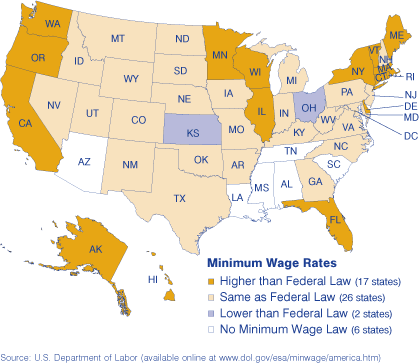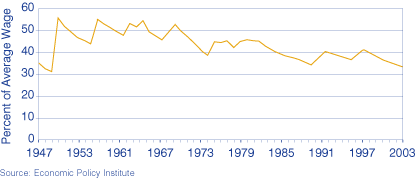The Minimum Wage
Indiana, along with 25 other states, has a minimum wage equal to the United States at $5.15 per hour. There are 17 states (including the District of Columbia) with minimum wages higher than the national figure, two states (Ohio and Kansas) are lower, while six states have no minimum wage (see Figure 1).
Figure 1: Minimum Wage Laws, 2005

The current nominal minimum wage has been in effect since 1997, as seen in Table 1. If we adjust for inflation, the real minimum wage, in terms of 2003 buying power, reached its peak in 1968. In that year, the nominal minimum was $1.60 but its real 2003 buying power was $7.18. From 1968 to 2003, the nominal minimum wage increased by $3.55, but in real buying power it has decreased by $2.03 or ‑28.3 percent. The minimum wage in our times is again about 35 percent of the average wage in the nation, just as it was in 1947 (see Figure 2).
Table 1: Minimum Wages, 1960 to 2003

Figure 2: Minimum Wage Relative to Average Hourly Wage, 1947 to 2003

If the minimum wage is increased, some workers will lose jobs. Other workers will retain their jobs and have more take-home pay. Therein lies the argument: How many jobs will be lost versus how many jobs will be retained? It is an argument that has persisted since the idea of a minimum wage was first introduced. Advocates on both sides declare that they have the definitive answers, but the truth probably is different in each of the thousands of labor markets across the nation.
Morton J. Marcus, Director Emeritus
Indiana Business Research
Center, Kelley School of Business, Indiana University
